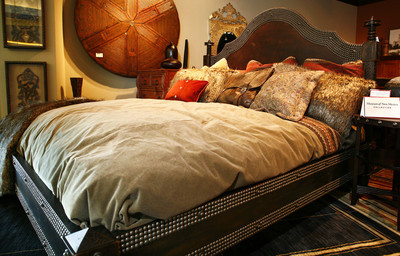Cultural Expedition

Who knew that you could get a lesson in American history while decorating your home?
But that’s exactly what happens when you encounter furniture and decorative accessories from the new Museum of New Mexico Collection.
“Our collection represents who we are as Americans,” said Pamela Kelly, director of licensing for the Museum of New Mexico Foundation. “We’re a nomadic people. … The West was, and is, a vast mosaic of shifting identities and definitions, where the peoples of extremely different backgrounds and beliefs came together over time in landscapes of bounty and scarcity, to forge new identities out of necessity and historical circumstance.”
While most people associate Santa Fe with the American West, few realize it was the jumping off spot for anyone traveling in the Western United States.
Because of this convergence of cultures, the collection is filled with influences from Europe, Asia and South Africa.
“Next to St. Petersburg, Fla., Santa Fe is the oldest city in the United States,” Kelly said. “From 1598 to 1821, you couldn’t come into that part of the U.S. unless you were a citizen of Spain.”
Pieces in the collection, which debuted at the recent Las Vegas Market at World Market Center Las Vegas, were inspired by artifacts in the foundation’s four Santa Fe museums: Palace of the Governors/New Mexico History Museum; Museum of International Folk Art; New Mexico Museum of Art; and Museum of Indian Arts & Culture. And, a portion of proceeds from the sale of the licensed pieces benefit the foundation.
The new collection is a joint effort between five manufacturers: T.S. Berry, King Hickory, Berry Creek, Quoizel and Shaw Living, which created case goods, upholstery, top of bedding, lighting and rugs, respectively.
Kelly said this is the third collection based on the museum’s artifacts and she believes it is the best. Sitting in T.S. Berry’s showroom, she said “He (designer Scott Jensen) captured the essence (of the museum’s collections). It’s elegant, beautiful and looks like the region, but it’s not a cliché. It’s very sophisticated or very casual. It’s spot on.”
“Part of what makes the Museum of New Mexico Collection more exciting to me is that every year my family would travel from Nebraska to New Mexico,” said Scott Jensen, general merchandise manager and designer for T.S. Berry. “My father was raised in Tucson (Ariz.) and I was exposed to the eclectic styles of the Southwest from an early age.”
Kelly believes the collection is ideal for today’s society, especially those who have moved to the West from other locations. “The collection is perfect for people who have picked up their lives and moved West,” she said. “The variety of styles — Spanish, native, rustic frontier and late Victorian — allow people to combine cherished possessions from their past with fresh takes on styles inspired by the place they now call home.”
That combination of styles is part of what Kelly calls the excitement of the West, which promised people the opportunity to start fresh. It also encourages people — now as well as decades ago — to break rules when it comes to decorating their homes.
The pieces, particularly the tables, chairs, beds, dressers, upholstery and accent pieces, were designed to be flexible in both scale and use. For example, the Morely bunching cabinet was inspired by a Spanish colonial dresser owned by Sylvanus Griswold Morely that was about 20 feet long. Instead, several of the smaller cabinets, which are just 32 inches wide, can be put together to create the look of one large piece, or they can be used individually to flank one of the collection’s four beds.
Morely, an anthropologist who was the first to translate Mayan hieroglyphics and served as a spy during World War I for the U.S. Navy to help it determine if there were German submarines and bases in South America, collected numerous Spanish colonial pieces and left his entire estate to the museum, Kelly said.
A 1700s console once owned by Morely and believed to be from a Guatemalan church inspired the Antigua table created by T.S. Berry.
Also featured in the collection is a near-exact replica of frontiersman Kit Carson’s game table. The piece, which combines a checkerboard with a cribbage board, was doubled in size. It has late-Victorian/Eastlake floral motifs.
The vast nature of the museum’s historic collection made it a challenge to determine which pieces to use as inspiration for the new furnishings.
“If anything, I had too many ideas,” Jensen said, adding that he saw hundreds of pieces that were made over a broad span of history when he visited the museum, which made it more difficult to limit the company’s offerings to just 50 elements for this market.
Still, he said, the experience was refreshing to him because as a modern consumer, he’s always looking for what’s new, what’s next.
“What we found was that while a piece might not have made a good translation to today’s consumers, it had good design elements,” Jensen said. “I saw a lot of modern lines — even if a piece was 200 years old.”
Such was the case of T.S. Berry’s Seville bed, one of Jensen’s favorite pieces in the collection. The bed, which features more than 5,000 individually placed nailhead accents on the headboard, footboard and side rails, was inspired by an African chair. “It is a tiny thing,” he said.
Although they could have changed the chair’s scale and turned it into a dining chair, Jensen said he chose to “give it more credit” and transform the look into a showcase piece.
At the home-furnishings market, retailers were embracing the entire collection and not just a few standout pieces, Jensen said. “I think this will ultimately help consumers. You need more than a few pieces to tell the story.”
Jensen added that he is especially pleased that the collection encompasses lighting, rugs and bedding as well as traditional furniture pieces.